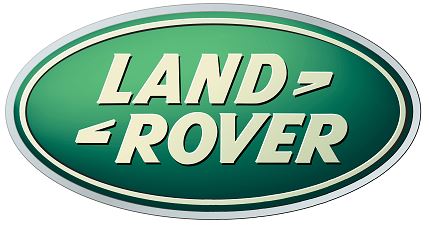 2023 Land Rover DEFENDER TOWING
2023 Land Rover DEFENDER TOWING
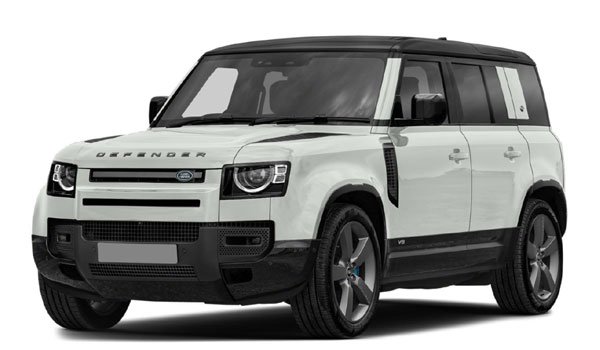
TOWING SAFETY
Make sure the following warnings and cautions have been read and fully understood before towing a trailer. Failure to follow the guidelines could result in vehicle damage, serious injury, or death.
- Do not exceed the Gross Vehicle Weight (GVW), maximum rear axle weight, or nose weight. Exceeding any of these limits adversely affects the vehicle’s stability and braking. Increased braking distances and loss of vehicle control may be experienced. See WEIGHTS.
- Only fit approved towing accessories. Vehicle stability may be compromised if non-approved detachable towing accessories are fitted.
- Only fit approved removable towing accessories. Non-approved removable towing accessories may obscure the rear lights and license plate.
- Never use the vehicle’s towing eyes or lashing points to tow a trailer.
Do not use weight distribution hitches as vehicle damage may occur.
TOWING WEIGHTS
Make sure the relevant safety warnings and cautions have been read and understood before towing a trailer. See TOWING SAFETY.
| Description | Variant | Maximum weight (kg) |
|---|---|---|
| Unbraked trailer towing mass. | All vehicles. | 750 |
| Towing mass.¹ | Plug-in Hybrid Electric Vehicles (PHEVs) and 130 vehicles only. | 3 000 |
| 3.0L diesel Mild Hybrid Electric Vehicles (MHEVs) fitted with 7 seats only. | 3 450 | |
| All vehicles except 3.0L diesel MHEVs fitted with 7 seats and PHEVs. | 3 500 | |
| Nose weight (Certified).² | All except 130 and Australian vehicles. | 150 |
| 130 vehicles only. | 120 | |
| Nose weight (Design).³ | Detachable tow ball. | 200 |
| All 130 vehicles. | 300 | |
| Deployable tow ball. | 350 | |
| Tow hitch tow ball. | 350 | |
| Multi-height tow ball. | 350 |
¹ The towing mass and Gross Train Weight (GTW) can be increased for certain markets. Information can be found on the Vehicle Identification Number (VIN) label. See LABEL LOCATIONS.
² When towing, the nose weight must be considered as part of the vehicle’s payload. Make sure that the Gross Vehicle Weight (GVW), the GTW, and the maximum rear axle weights are not exceeded. If required, remove weight from the vehicle to facilitate the nose weight.
³ For Australia the maximum nose weight only applies to trailers with braking systems compliant with ADR 38/02 Clause 5 and VSB1 Section 15. Make sure that the GVW, the GTW, and the maximum rear axle weight limits are not exceeded when applying the trailer nose weight. Reduce the vehicle’s payload if required. For more information, visit https://www.legislation.gov.au/Details/F2007C00493 and https://www.infrastructure.gov.au/vehicles/vehicle_regulation/bulletin/vsb1/vsb_01_b.aspx#anc_15.
Make sure to never exceed the GVW, the GTW, or the front and rear axle weights. See WEIGHTS.
- Include the trailer’s nose weight when calculating the GVW and rear axle weight.
- When calculating the vehicle’s rear axle weight, the vehicle’s payload weights must also be considered. Include the combined weights of all the rear passengers, the loadspace, roof rails, accessory equipment, and the trailer’s nose weight. The combined weights must never exceed the GVW or the maximum weights for the front and rear axles.
- For every 1 000 meters increase in height above sea level, the GTW must be reduced by 10%.
- Make sure the legal requirements for the country in which the vehicle is traveling are observed.
- For further information, contact a retailer/authorized repairer and quote the VIN. See LABEL LOCATIONS.
TOW BAR OPTIONS
Make sure the relevant safety warnings and cautions have been read and understood before towing a trailer. See TOWING SAFETY.
A number of different tow bar options are available for the vehicle.
Make sure that a breakaway cable, or breakaway chains, are used and connected, as illustrated.
Do not loop a breakaway cable or safety chain over the tow ball. The cable or chain may slide off, preventing correct operation in the event that the trailer becomes disconnected. Failure to correctly secure a breakaway cable or chain could result in serious injury or death.

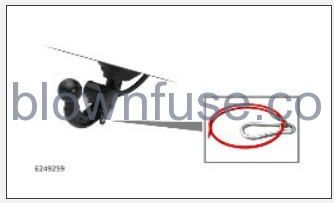
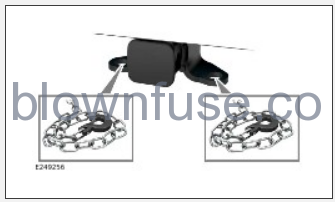
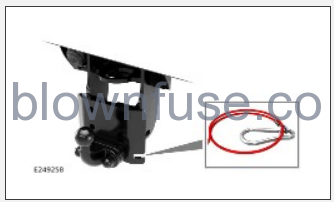
TOW HITCH (AUSTRALIA AND NEW ZEALAND ONLY)
Make sure the relevant safety warnings and cautions have been read and understood before towing a trailer. See TOWING SAFETY.
The fitting of a tow hitch is required for towing with the tow hitch receiver.
The following tow hitch dimensions must be adhered to:
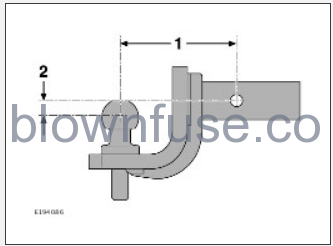
- The maximum recommended length is 175 mm.
- The maximum recommended ball height is:
Coil suspension: -15 mm.
Air suspension: 35 mm.
Never leave the tow hitch loose in the vehicle. In the event of an accident, or during heavy braking, the tow hitch can become a projectile potentially causing serious injury or death.
If in any doubt about the fitment of a tow hitch, consult a retailer/authorized repairer.
TOWING A TRAILER
Make sure the relevant safety warnings and cautions have been read and understood before towing a trailer. See TOWING SAFETY.
Before towing a trailer, make sure both the vehicle and the trailer are being used in accordance with the manufacturer’s recommendations, and any applicable legislation. See TOWING WEIGHTS and WEIGHTS.
Engage low range in order to achieve a smoother pull away from standstill when towing a trailer weighing more than 2 000 kg. Change to high range once the vehicle is moving. See SELECTING HIGH AND LOW RANGE.
To avoid overheating the transmission, it is not advisable to tow heavy loads at speeds of less than 32 km/h (20 mph) in high range. In these circumstances, select low range.
A reduction in the performance of the Air Conditioning (A/C) system is normal under high load towing conditions.
The touchscreen can display a rear-view image to assist when reversing the vehicle with a trailer attached. See TOW ASSIST and ADVANCED TOW ASSIST.
HITCH ASSIST
Make sure the relevant safety warnings and cautions have been read and understood before towing a trailer. See TOWING SAFETY.
Hitch assist displays a rear camera image on the touchscreen, to aid in the process of connecting a trailer. Hitch assist overlays an approximation of the tow ball’s position, and the intended steering direction.
The driver is responsible for calculating correct distances and maneuvering the vehicle to a trailer’s tow hitch. Failure to maneuver the vehicle accurately may result in damage to the vehicle and trailer.
The accuracy of the hitch assist is affected by the height of the trailer’s tow hitch compared to the vehicle’s tow ball. The maximum height difference should be no more than 3 cm (1.2 in).
To activate hitch assist:
- Select Reverse (R). The touchscreen automatically displays a rear-view camera image.
- Select TOWING.
- Reverse the vehicle towards the trailer.
The rear camera zooms in to enlarge the view as the vehicle closes to within 1 m of the trailer’s tow hitch.
Maneuver the vehicle until it is in the required position.
TRAILER ELECTRICAL CONNECTION
Make sure the relevant safety warnings and cautions have been read and understood before towing a trailer. See TOWING SAFETY.
The information in the following table should be used to confirm if a trailer or lighting board is compatible with the vehicle. The vehicle is unable to detect a trailer or lighting board that does not meet the specifications given.
| Function | Minimum load | Maximum load | ||
|---|---|---|---|---|
| Amps | Watts | Amps | Watts | |
| Brake lights. | 0.1 | 1.2 | 10 | 120 |
| Direction indicators. | 0.05 | 0.6 | 5 | 60 |
| All side marker lights combined. | – | – | 10 | 120 |
| Reverse lights. | – | – | 5 | 60 |
| Fog light. | – | – | 5 | 60 |
| All lights combined. | – | – | 25 | 300 |
| Permanent battery feed. | – | – | 15 | 180 |
| Ignition feed. | – | – | 15 | 180 |
Only use equipment that requires a 12-volt supply from the vehicle.
Only attach appropriate electrical connectors, which are in good condition, to the trailer socket. Using inappropriate or sub-standard towing equipment may adversely affect the accuracy and performance of the vehicle’s towing features.
The trailer direction indicator lamp flashes alongside the relevant direction indicator lamp in the instrument panel when:
- An electrical connection is present between the vehicle and the trailer.
- The vehicle’s direction indicators are used.
If the trailer direction indicator lamp does not flash, check the trailer’s electrical connection. Take appropriate action to make sure the trailer’s direction indicators are functioning correctly.
An electric trailer brake module connector is located near the driver’s position. The information in the following table should be used to confirm if an electric trailer brake module is compatible with the vehicle. If in doubt, contact a retailer/authorized repairer.
| Function | Maximum load |
|---|---|
| Permanent battery feed. | 30 A |
| Brake signal. | 100 mA |
| Electric brake connection to tow bar electrical socket. | 30 A |
TRAILER STABILITY ASSIST (TSA)
Make sure the relevant safety warnings and cautions have been read and understood before towing a trailer. See TOWING SAFETY.
Trailer Stability Assist (TSA) automatically detects when sway is developing on a correctly attached trailer. When active, TSA gradually reduces the vehicle’s speed to help regain control of the trailer.
TRAILER STABILITY ASSIST (TSA) LIMITATIONS
Trailer Stability Assist (TSA) does not operate if:
- The trailer is jack-knifing.
- Dynamic Stability Control (DSC) is switched off.
TSA performance may be reduced when travelling on slippery surfaces.
TRAILER CALIBRATION
Make sure the relevant safety warnings and cautions have been read and understood before towing a trailer. See TOWING SAFETY.
The tow assist features do not operate until a trailer profile is created, and the corresponding trailer is connected and calibrated. A trailer profile must be created before the trailer is calibrated.
The trailer does not need to be connected to the vehicle to create a profile. The trailer must be connected to the vehicle in order to be calibrated.
To create a trailer profile:
- Touch the apps icon on the driver sidebar. See TOUCHSCREEN HOME MENU.
- Select TOWING & TRAILERS.
- Select +.
- Select the trailer type from the available options.
- Enter the trailer dimensions.
Follow the on-screen instructions to calibrate the trailer, if it is already connected.
Create two trailer profiles for open trailers for greater system accuracy. For example, create one profile with the trailer loaded with a boat, vehicle, etc., and one profile with the trailer unloaded.
The trailer calibration process may not perform accurately in low ambient light levels. Always attempt to calibrate a trailer in good ambient light levels. Failure to accurately carry out the calibration process may result in damage to the vehicle or trailer.

The tow assist icon displays on the touchscreen when a trailer is connected. Select the appropriate trailer profile.
If the trailer has yet to be calibrated:
- Touch the tow assist icon.
- Select the appropriate trailer profile.
- Follow the on-screen instructions to calibrate the trailer.
TOW ASSIST
Make sure the relevant safety warnings and cautions have been read and understood before towing a trailer. See TOWING SAFETY.
Tow assist only operates if the connected trailer has had a profile created and has been calibrated. See TRAILER CALIBRATION.
Tow assist displays camera views of the rear or side of the vehicle, to assist the driver when reversing a trailer. Trajectory lines are overlaid onto the images, depicting the predicted path of the trailer. Different camera views can be selected via the touchscreen. See CAMERA SYSTEM OVERVIEW.
Tow assist can be configured to use either the surround camera system or the rear camera system.

The tow assist icon displays on the touchscreen passenger side bar when a trailer is connected. See CAMERA SYSTEM OVERVIEW.
To activate tow assist:
- Touch the tow assist icon.
- Select the appropriate profile for the connected trailer.
- Select Reverse (R).
The trajectory lines change color based on the angle of the trailer in relation to the vehicle. Red trajectory lines indicate that damage may occur to the vehicle or trailer if the steering is turned further in the same direction.
TOW ASSIST LIMITATIONS
The following may have an effect on tow assist performances:
- Varying ambient light conditions: If varying light conditions are experienced, the trajectory lines are removed from the touchscreen image.
- If a door or taildoor is opened: In this event, the corresponding camera view is replaced with a black screen.
- If the camera wash feature is used: In this event, the rear camera view becomes unclear.
ADVANCED TOW ASSIST
Make sure the relevant safety warnings and cautions have been read and understood before towing a trailer. See TOWING SAFETY.
Advanced tow assist only operates if the connected trailer has had a profile created, and has been calibrated. See TRAILER CALIBRATION.
Advanced tow assist displays camera views of the rear and side of the vehicle, to assist the driver when reversing a trailer. Trajectory lines are overlaid onto the images, depicting the path of the trailer. Different camera views can be selected via the touchscreen. See CAMERA SYSTEM OVERVIEW.
Advanced tow assist also operates the steering wheel when the vehicle is reversing, and all conditions are met.
The vehicle’s speed and brakes must be controlled by the driver.
The driver is responsible for detecting obstacles, and for estimating both the trailer and vehicle’s distance from the obstacles when maneuvering. Failure to do so can result in vehicle or trailer damage, serious injury, or death.

The tow assist icon displays on the touchscreen passenger side bar when a trailer is connected.
To enable advanced tow assist:
- Touch the tow assist icon.
- Select the appropriate profile for the connected trailer.

The advanced tow assist icon displays on the touchscreen passenger side bar once a trailer profile is selected.
Select Reverse (R).
To activate advanced tow assist:
- Touch the advanced tow assist icon on the touchscreen.
- Select START.

An advanced tow assist icon on the front control panel now illuminates. The driver’s side rotary climate control can now be used to control the path of the trailer when reversing.
Press and hold the driver’s side rotary climate control for approximately a second to align the trailer straight in relation to the vehicle.
When the required path has been set using the rotary climate control, use the accelerator and brake pedals to maneuver the trailer.
The driver can take control of the steering wheel if required. In this event, advanced tow assist is canceled.
The trajectory lines change color as follows:
- Green lines indicate that the trailer is reversing in a straight line.
- Magenta lines indicate that the trailer is reversing at an angle.
- Red lines indicate that the trailer’s reversing angle is too tight. Red lines are accompanied by a warning message on the touchscreen.
The vehicle’s ignition must be switched off before disconnecting a trailer.
ADVANCED TOW ASSIST LIMITATIONS
Advanced tow assist does not operate if:
- Any gear other than Reverse (R) is selected.
- The steering wheel is used to maneuver the vehicle.
- The taildoor is open, or unlatched.
- Any of the doors are opened, or unlatched.
- All Terrain Progress Control (ATPC) is enabled.
- The vehicle’s speed exceeds 8 km/h (5 mph).
Advanced tow assist performance is adversely affected if non-approved towing equipment is used.
The touchscreen displays messages to inform the user of any conditions that have not been met in order for the system to operate. The touchscreen also displays messages regarding system faults or performance issues.
FITTING THE DETACHABLE TOW BALL
Make sure the relevant safety warnings and cautions have been read and understood before towing a trailer. See TOWING SAFETY.
The detachable tow ball is very heavy. Extreme care must be taken when maneuvering the tow ball. Use two hands to safely maneuver the tow ball. Make sure that no body part is below the tow ball during fitment or removal. Failure to safely maneuver the tow ball could result in serious injury or death.
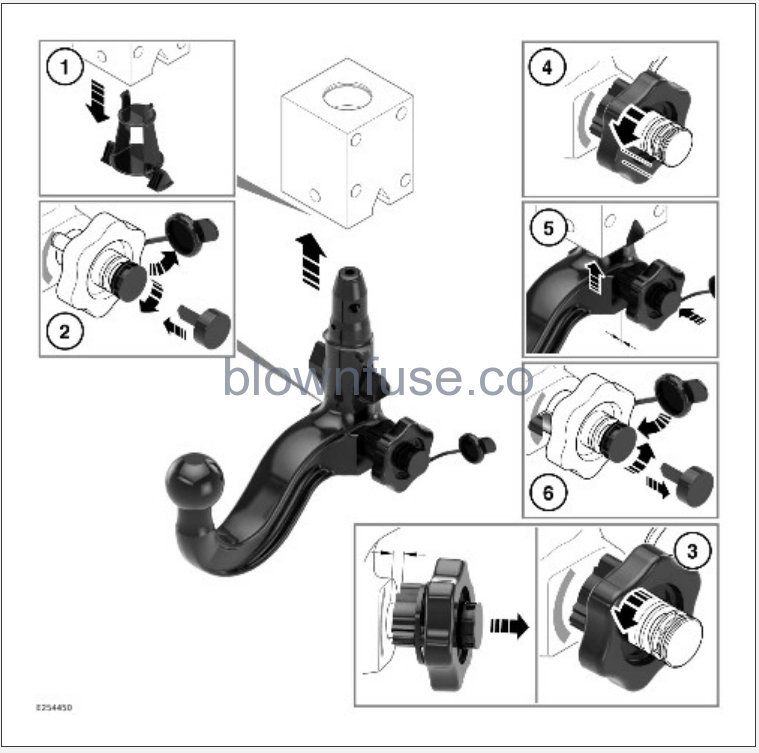
The detachable tow ball is stored under the loadspace floor.
To fit the detachable tow ball:
- Remove the protective cover from the mounting bracket. Store in a safe place.
NOTES
Take note of the orientation of the cover to aid refitting. - Insert the key and turn clockwise to unlock the handwheel.
- Pull the handwheel away from the tow ball. Simultaneously turn the handwheel approximately half a turn counter-clockwise. The red lug on the handwheel should enter the green indicator scale.
- Rotate the handwheel counter-clockwise until it locks into position. The red lug should remain in the green indicator scale.
- Using both hands, push the tow ball up into the mounting bracket. A click is heard when the tow ball is fitted correctly. The handwheel returns to sit flush against the tow ball. The green indicator lug should be aligned with the green indicator scale.
- Insert the key and turn counter-clockwise to lock the handwheel.
Once the tow ball is fitted, replace the keyhole cover and safely store the key below the loadspace floor.
The detachable tow ball should be removed if it is not required for immediate use. See REMOVING THE DETACHABLE TOW BALL.
Make sure the detachable tow ball is stored safely in its bag using the lashing eyes on the loadspace floor. In the event of an accident, or under heavy braking, the tow ball can become a projectile, potentially causing serious injury or death.
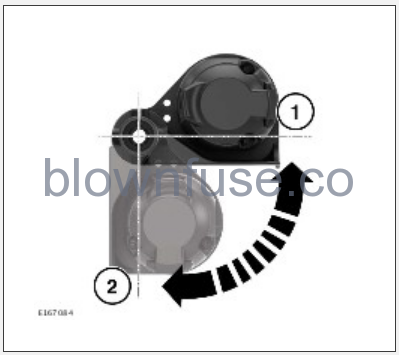
The trailer electrical socket is mounted on the tow bar.
Move the electrical socket into the deployed position (2). Make sure to move the electrical socket back into the stored position (1) once the tow ball is removed.
REMOVING THE DETACHABLE TOW BALL
Make sure the relevant safety warnings and cautions have been read and understood before towing a trailer. See TOWING SAFETY.
The detachable tow ball is very heavy. Extreme care must be taken when maneuvering the tow ball. Use two hands to safely maneuver the tow ball. Make sure that no body part is below the tow ball during fitment or removal. Failure to safely maneuver the tow ball could result in serious injury or death.
To remove the detachable tow ball:
- Remove the keyhole cover.
- Insert the key.
- While supporting the tow ball, turn the key clockwise to unlock the handwheel.
- Pull the handwheel away from the tow ball. Simultaneously rotate the handwheel approximately half a turn counter-clockwise until it locks into position. The red lug on the handwheel should enter the green indicator scale.
- Using both hands, lower the tow ball from the mounting bracket.
- Fit the top cover to the tow ball. When correctly fitted a click is heard, and the handwheel returns inwards to sit flush against the tow ball. The green indicator lug should be aligned with the green indicator scale.
NOTES
Repeat step 2 if there is an insufficient gap between the tow ball and the handwheel to fit the top cover. - Turn the key counter-clockwise to lock the handwheel.
- Remove the key.
NOTES
The key can only be removed if the top cover has been fitted correctly. - Refit the keyhole cover.
- Securely store the tow ball and key in the loadspace.
WARNING
Make sure the tow ball is stored safely in its bag using the lashing eyes on the loadspace floor. In the event of an accident, or under heavy braking, the tow ball can become a projectile, potentially causing serious injury or death. - Fit the protective cover to the mounting bracket.
DEPLOYABLE TOW BALL OVERVIEW
Make sure the relevant safety warnings and cautions have been read and understood before towing a trailer. See TOWING SAFETY.
The deployable tow ball is stowed out of view, underneath the centre of the rear bumper.
The deployable tow ball can be deployed in one of two ways:
- Via the touchscreen. See DEPLOYABLE TOW BALL OPERATION.
- Via buttons located on the left side of the loadspace. See DEPLOYABLE TOW BALL OPERATION.
Before deploying the tow ball it is important to make sure that:
- The vehicle is stationary.
- Park (P) or Neutral (N) is selected.
- The Electric Parking Brake (EPB) is applied.
- There are no obstructions within close proximity of the tow ball.
Additionally, before stowing the tow ball it is important to make sure that:
- The trailer is disconnected.
- The trailer’s electrical connection is disconnected.
Failure to disconnect the trailer or the trailer’s electrical connection before stowing the tow ball could lead to vehicle and trailer damage.
The deployable tow ball incorporates a measure load feature. See MEASURE LOAD.
DEPLOYABLE TOW BALL OPERATION
Make sure the relevant safety warnings and cautions have been read and understood before towing a trailer. See TOWING SAFETY.
It is recommended to keep the deployable tow ball in the stowed position when not in use. Failure to do so could lead to vehicle damage or personal injury.
The deployable tow ball can be operated using either the touchscreen or by using buttons located on the left side of the loadspace.
Operating the tow ball many times in quick succession may cause the system to stop working. Operation is resumed after approximately 90 minutes. If the operation is not resumed, consult a retailer/authorized repairer.
To deploy the tow ball using the touchscreen:
- Touch the Apps icon on the driver’s sidebar. See TOUCHSCREEN HOME MENU.
- Select TOW BAR.
- Select Deploy.
Once moving, the Deploy soft key is replaced with a Cancel soft key. Once fully deployed, the Cancel soft key is replaced with a Stow soft key.
If the tow ball stops halfway, or the system cannot determine the position of the tow ball, the tow ball reset procedure must be used. See DEPLOYABLE TOW BALL RESET.
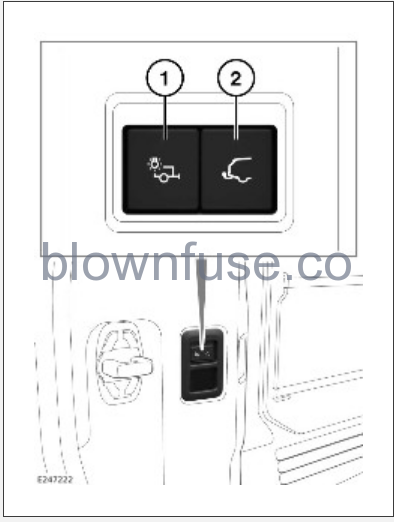
- Bulb check button. See BULB CHECK.
- Deploy and stow button.
Press button 2 to deploy the tow ball. Press the button a second time to stow the tow ball.
The loadspace buttons do not operate if the taildoor is closed.
An LED located above the button confirms tow ball status as follows:
- Flashes slowly while the tow ball is being deployed or stowed. An audible tone also sounds.
- Stops flashing and remains illuminated once the tow ball is fully deployed.
- Stops flashing and extinguishes after 2 seconds once the tow ball is fully stowed.
- Flashes quickly for 2 seconds if a single obstruction is encountered during operation. An audible tone also sounds for 2 seconds.
If the LED continues to flash, the tow ball is neither fully deployed nor fully stowed. An audible tone also sounds continuous until the tow ball is reset. Do not tow a trailer with the tow ball partially deployed. Serious injury or death may result. See DEPLOYABLE TOW BALL RESET.
Press the button to cancel the current operation of the tow ball. The tow ball returns to it previous position.
A second press of the button during operation will stop the tow ball mid-cycle. The tow ball reset procedure must be used if this occurs.
DEPLOYABLE TOW BALL RESET
The reset procedure is required if the tow ball can neither fully deploy or stow. For example, if an obstruction is met more than once.
Meeting an obstruction a single time results in the tow ball returning to its last known position, i.e, fully deployed or fully stowed. If the tow ball is obstructed for a second time during operation it stops mid-cycle.
The requirement for a reset procedure is confirmed if all the following occur:
- The touchscreen displays a message telling the user to reset the system.
- The button LED in the loadspace flashes quickly.
- An audible tone sounds continuous.
To reset the deployable tow ball:
- Press the loadspace button. The audible tone stops. See DEPLOYABLE TOW BALL OPERATION.
- Press the loadspace button a second time. The tow ball resets.
NOTES
The tow ball is always in the deployed position at the end of the reset procedure.
If the problem persists, consult a retailer/authorized repairer. Do not tow a trailer with the tow ball partially deployed. Serious injury or death may result.
BULB CHECK
The bulb check feature allows an observer to perform a visual check on the operation of the exterior lights.
A bulb check on both the vehicle and connected trailer lights can be carried out via the touchscreen. Alternatively, the buttons located on the left side of the loadspace can be used.
The vehicle does not display any warnings for faulty trailer lights.
Before carrying out a bulb check:
- Switch off all of the vehicle’s lights.
- Apply the Electric Parking Brake (EPB).
- Switch off the vehicle’s ignition.
The bulb check illuminates all of the vehicle’s lights and the corresponding trailer lights in turn. The sequence automatically stops after 3 minutes.
Check that each trailer light illuminates at the same time as the corresponding vehicle light when carrying out either of the operations shown below.
To carry out a bulb check using the touchscreen:
- Press the audio on/off button to power the touchscreen. See DRIVER CONTROLS.
- Touch the Apps icon on the touchscreen driver side bar. See TOUCHSCREEN HOME MENU.
- Select TOW BAR.
- Select TRAILER BULB CHECK.
- Follow the on-screen instructions.
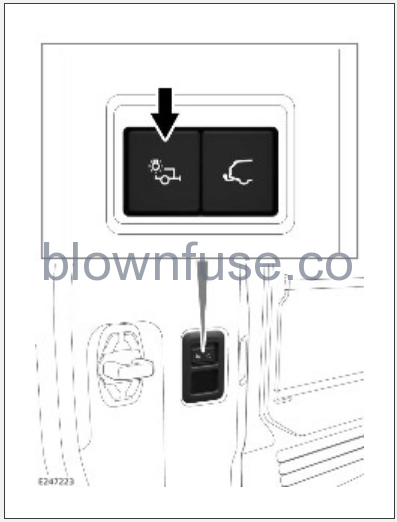
Press the button on the left side of the loadspace to carry out a bulb check. Press the button a second time to stop the bulb check.
MEASURE LOAD
Make sure the relevant safety warnings and cautions have been read and understood before towing a trailer. See TOWING SAFETY.
The deployable tow bar incorporates a measure load feature. The measure load feature allows the user to view an indicated nose weight range for a connected trailer.
The displayed weights are for guidance only, and are not accurate weight calculations.
To activate the measure load feature:
- Touch the apps icon on the driver’s sidebar. See TOUCHSCREEN HOME MENU.
- Select TOW BAR.
- Select MEASURE LOAD.
Operating the measure load feature 5 times in quick succession may cause the system to stop working. In this event, the touchscreen displays a message informing the user to perform a calibration procedure. To calibrate the feature disconnect the trailer from the vehicle. Once the trailer is disconnected stow then deploy the tow ball. See DEPLOYABLE TOW BALL OPERATION.
If the measure load feature develops a fault, disconnect the trailer from the vehicle. Once the trailer is disconnected carry out the deployable tow ball reset procedure. See DEPLOYABLE TOW BALL RESET.
MEASURE LOAD LIMITATIONS
The measure load feature only operates correctly if:
- The normal suspension height is selected. See NORMAL HEIGHT.
- The vehicle and connected trailer are parked on level ground.
- The connected trailer is not tilted forward or rearward.
The measure load feature may not operate if:
- The ambient temperature is below -20ºC, or above 60ºC.
- The vehicle and connected trailer are parked on excessive inclines.
The touchscreen displays messages to inform the user of any system performance issues. If messages are displayed during the measure load operation, carry out the deployable tow ball reset procedure. DEPLOYABLE TOW BALL RESET.
ESSENTIAL TOWING CHECKS
Make sure the relevant safety warnings and cautions have been read and understood before towing a trailer. See TOWING SAFETY.
The following checks must be carried out before towing:
- Do not exceed the maximum permissible towing weights. See TOWING WEIGHTS.
- Load the trailer to achieve an even weight distribution between the axles when towing a trailer with more than one axle,
- Remember to include the weight of the trailer, plus the weight of the load, when calculating the laden weight of the trailer.
- Spread the load of any cargo between the vehicle’s loadspace and the trailer, if possible. Loading more weight into the vehicle generally improves stability. Make sure not to exceed the vehicle’s weight limits.
- Check that the tire pressures are correct for the current loading condition of the vehicle.
- Make sure that a suitable breakaway cable or chain, or safety coupling, is used and correctly connected. Refer to the trailer manufacturer’s guidelines. See TOW BAR OPTIONS.
- Make sure that the tow ball is secure.
- Check the operation of all the trailer lights.
TOW BALL MOUNTED ACCESSORIES
Only use Jaguar Land Rover approved tow ball mounted accessories. The use of unapproved tow ball accessories may result in severe damage to the tow ball and the tow bar.
It is not permitted to fit a non-removable, non-adjustable mounting that obscures the rear lights or the vehicle’s number plate.
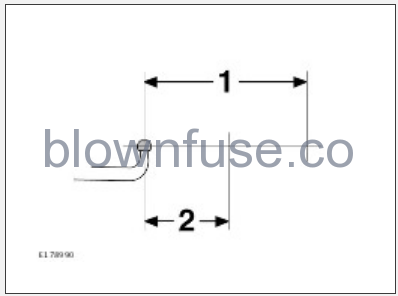
Observe the following before fitting an accessory to the tow ball:
- The attached accessory must not protrude more than 700 mm from the tow ball.
- The centre of gravity of the attached accessory and its load must not exceed a distance of 370 mm from the tow ball. The maximum weight at this distance should not exceed 69.1 kg.
The forces exerted by a trailer’s nose weight and tow ball-mounted accessories are different in nature, so different limits apply.
